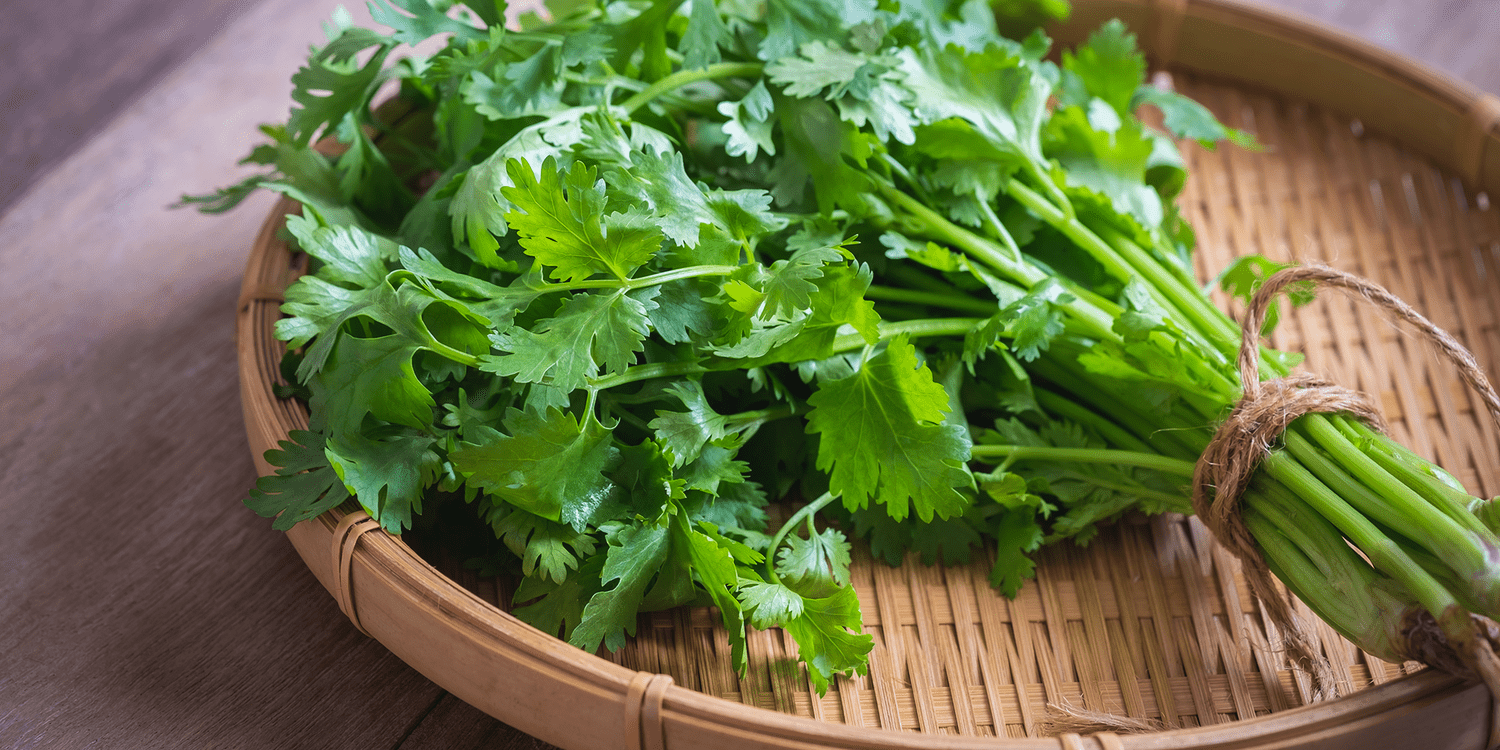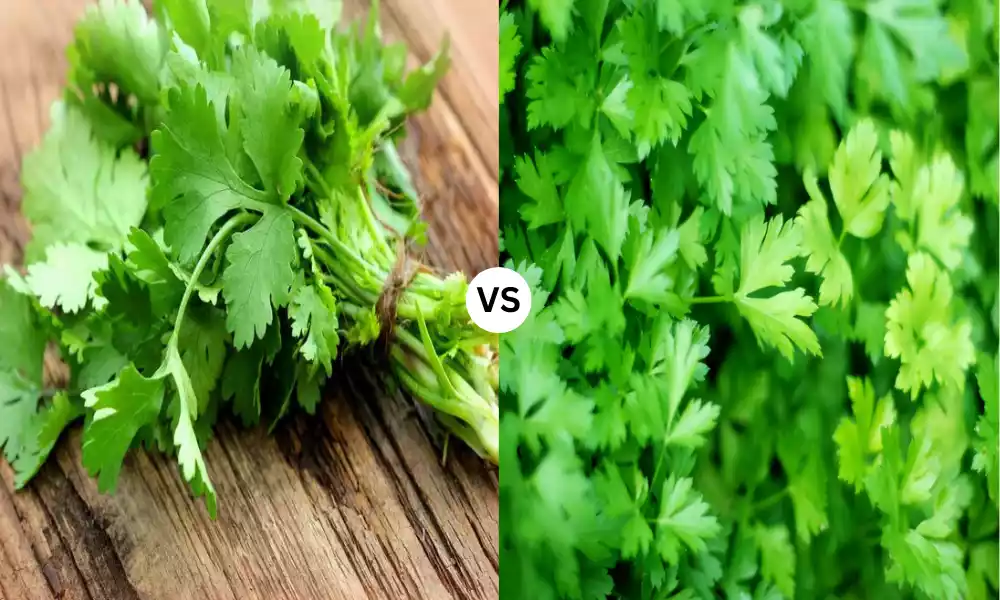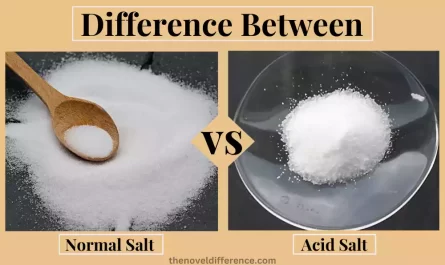Cilantro and parsley are two distinct herbs commonly used in culinary practices worldwide, each with its unique flavor and appearance. Cilantro, known for its fresh, citrusy, and sometimes ‘soapy’ taste, is a staple in Mexican, South Asian, and Middle Eastern cuisines, typically used fresh in dishes like salsas and curries.
Parsley, on the other hand, with its more subtle, slightly peppery taste, is prevalent in European, Middle Eastern, and American cooking, used both fresh and cooked in a variety of dishes from garnishes to soups and sauces.
While they may look similar with their bright green leaves, cilantro’s leaves are softer and more rounded, whereas parsley, especially the Italian variety, has flatter, more pointed leaves. Their distinct flavors mean they are not usually interchangeable in recipes.
Definition of Cilantro
Cilantro refers to the fresh leaves of the Coriandrum sativum plant, widely used as a culinary herb. It is characterized by its bright green, delicate leaves, and a distinctive flavor that ranges from citrusy to slightly soapy, depending on individual taste perceptions.

Cilantro is integral to various global cuisines, including Latin American, Asian, and Middle Eastern dishes, often used fresh in salsas, salads, and as a garnish. The term “cilantro” is primarily used in the Americas, while the leaves and plant are referred to as “coriander” in other parts of the world. Additionally, the dried seeds of the same plant are known as coriander seeds, which are used as a spice with a different flavor profile.
Culinary Uses
Cilantro, with its unique and refreshing flavor, is used extensively in various culinary traditions around the world. Here are some of its common culinary uses:
- Mexican Cuisine: Cilantro is a staple in Mexican cooking. It is used in salsas, like pico de gallo, and guacamole, and as a topping for tacos, enchiladas, and other traditional dishes.
- Indian Cuisine: In Indian cuisine, cilantro is often used in chutneys, garnishing curries, and as an integral part of spice mixes. It’s also commonly added to the dough for bread like parathas.
- Southeast Asian Cuisine: In Thai, Vietnamese, and other Southeast Asian cuisines, cilantro is added to soups (like pho), salads, spring rolls, and marinades, contributing a fresh and zesty flavor.
- Middle Eastern Cuisine: It’s used in dishes like tabbouleh, falafel, and various dips. Cilantro pairs well with lemon, garlic, and olive oil in these cuisines.
- Salads and Dressings: Fresh cilantro leaves are often added to salads for a burst of flavor. Cilantro-based dressings and vinaigrettes are also popular.
- Rice Dishes: It’s used in rice preparations, such as cilantro lime rice, which is a common side dish in Latin American and Caribbean cuisines.
- Sauces and Marinades: Cilantro is a key ingredient in various sauces, like chimichurri, and is used in marinades to impart a fresh and tangy flavor to meats and vegetables.
- Stews and Soups: It’s also incorporated into stews and soups for its aromatic and citrusy notes.
- Beverages: Fresh cilantro is sometimes used in green smoothies and juices for its health benefits and distinct taste.
The herb is typically used fresh, as cooking can diminish its delicate flavor. The stems are also flavorful and can be used in cooking. Given its potent flavor, cilantro is usually added towards the end of the cooking process or used as a garnish.
Nutritional Profile
Cilantro, known for its fresh flavor and aroma, also offers a range of nutritional benefits. Here’s a breakdown of its nutritional profile:
- Low in Calories: Cilantro is very low in calories, making it a great addition to diets without adding significant caloric content.
- Vitamins: It is a good source of Vitamins A, C, and K. Vitamin A is important for vision and immune function, Vitamin C is crucial for the immune system and skin health, and Vitamin K plays a key role in blood clotting and bone health.
- Minerals: Cilantro contains minerals like potassium, which is essential for heart function and muscle contractions, and small amounts of calcium, iron, and magnesium.
- Antioxidants: This herb is rich in antioxidants, which help in combating free radicals in the body, potentially reducing inflammation and preventing certain chronic diseases.
- Dietary Fiber: While typically consumed in small amounts, cilantro does provide some dietary fiber, beneficial for digestive health.
- Detoxifying Properties: Some studies suggest cilantro may help in detoxifying the body from heavy metals, although more research is needed in this area.
- Low in Carbohydrates and Fat: Cilantro contains minimal amounts of carbohydrates and fats, making it a suitable addition to various diets, including low-carb and low-fat diets.
While cilantro is nutritious, it is usually consumed in small quantities as a garnish or flavoring, so its contribution to daily nutrient intake is generally modest. However, its inclusion in a balanced diet can add both flavor and nutritional benefits.
Health Benefits
Cilantro, beyond its culinary uses, offers several health benefits due to its nutrient content and bioactive compounds. Here are some of the notable health benefits associated with cilantro:
- Rich in Antioxidants: Cilantro contains antioxidants, which help in reducing oxidative stress in the body. These antioxidants can neutralize free radicals, potentially reducing inflammation and lowering the risk of various chronic diseases.
- May Aid in Detoxification: Some studies suggest that cilantro can bind to heavy metals like lead, arsenic, and cadmium, helping to detoxify the body, although more research is needed to fully understand this effect.
- Supports Heart Health: The antioxidants and vitamins in cilantro, such as vitamin K, are beneficial for heart health. They can help in reducing blood pressure and improving cholesterol levels, thus reducing the risk of heart disease.
- Promotes Digestive Health: Cilantro can aid in digestion and help to settle an upset stomach. It has been traditionally used for its digestive properties in various folk medicines.
- Has Antibacterial Properties: Certain compounds in cilantro, like duodenal, have been found to have antibacterial properties, particularly against foodborne illnesses like Salmonella.
- May Help Control Blood Sugar Levels: Some animal studies indicate that cilantro may help in managing blood sugar levels, making it a potentially beneficial herb for people with diabetes. However, more research is needed in humans.
- May Improve Sleep Quality: Due to its mild sedative effects, cilantro has been used in traditional medicine practices to improve sleep quality and reduce anxiety.
- Supports Skin Health: Rich in vitamins A and C, cilantro may benefit skin health by providing essential nutrients that aid in maintaining skin integrity and immunity.
- Anti-inflammatory Effects: The anti-inflammatory properties of cilantro may help in reducing inflammation in the body, potentially benefiting conditions like arthritis.
While cilantro offers these health benefits, it’s important to remember that it is usually consumed in small amounts as an herb. Therefore, its contribution to your overall nutrient intake is relatively small, and it should be included as part of a balanced diet for best results. As with any dietary component, cilantro’s benefits are most effective when combined with an overall healthy lifestyle.
Definition of Parsley
Parsley is a culinary herb known botanically as Petroselinum crispum. It’s widely used in various cuisines around the world and is recognized for its bright green, feather-like leaves and clean, slightly peppery taste. Parsley comes in two main varieties: curly-leaf parsley, with ruffled leaves, and Italian or flat-leaf parsley, which has flat, pointed leaves.

This herb is not only used for its flavor but also its decorative appearance as a garnish. Parsley is rich in vitamins and minerals, particularly vitamins A, C, and K, and is often used in cooking both as a flavor enhancer and for its nutritional benefits. It’s a versatile ingredient, featured in dishes ranging from soups and salads to sauces and marinades.
Culinary Uses
Parsley, with its fresh and slightly peppery flavor, is a versatile herb used extensively in various culinary traditions. Here are some of its common culinary uses:
- Garnishing: Perhaps the most common use of parsley is as a garnish. Its bright green color and fresh taste make it an ideal finishing touch for a wide variety of dishes.
- Salads: Parsley is a key ingredient in salads, including the famous Middle Eastern tabbouleh, where it’s used in large quantities alongside bulgur wheat, tomatoes, and a lemony dressing.
- Sauces and Pesto: It’s often blended into sauces, such as the Italian salsa verde or used to make pesto, in place of or alongside basil.
- Soups and Stews: Parsley adds depth and freshness to soups and stews. It’s commonly added towards the end of the cooking process to retain its flavor.
- Marinades and Seasonings: Chopped parsley is a great addition to marinades and seasoning mixes for meats, fish, and poultry.
- Herb Mixes: It’s a component of various herb mixtures, such as the French fines herbes and the bouquet garni, used to flavor stocks, soups, and sauces.
- Sandwiches and Wraps: Fresh parsley can be added to sandwiches and wraps for an extra burst of flavor.
- Breads and Doughs: Chopped parsley can be mixed into bread doughs or sprinkled on top of bread before baking for added taste and aesthetics.
- Vegetable Dishes: It pairs well with many vegetables and can be added to stir-fries, roasted vegetable dishes, and casseroles.
- Butter and Cream Cheeses: Parsley is often mixed into compound butter or cream cheeses to create flavorful spreads.
Parsley is often used fresh to retain its flavor and nutritional benefits, but it can also be used in its dried form, albeit with a somewhat different taste profile. In cooking, parsley is typically added towards the end of the cooking process to preserve its delicate flavor and vibrant color.
Nutritional Profile
Parsley is not only a flavorful herb but also a nutritious addition to the diet. Here’s a breakdown of its nutritional profile:
- Vitamins: Parsley is an excellent source of Vitamin K, which is important for bone health and blood clotting. It also contains good amounts of Vitamins A and C, which are important for vision, immune function, and skin health.
- Minerals: This herb is a source of iron, important for the formation of red blood cells, and folate, a crucial nutrient for DNA synthesis and repair. It also provides small amounts of calcium, potassium, and magnesium.
- Low in Calories: Parsley is very low in calories, making it a great addition to meals for those watching their caloric intake.
- Rich in Antioxidants: It contains flavonoids, carotenoids, and Vitamin C, all of which have antioxidant properties. Antioxidants help in fighting free radicals, potentially reducing the risk of certain diseases.
- Dietary Fiber: While typically consumed in small amounts, parsley does offer dietary fiber, which is beneficial for digestive health.
- Chlorophyll: The rich green color of parsley indicates its high chlorophyll content, which has been linked to certain health benefits like promoting detoxification.
- Low in Carbohydrates: Parsley is low in carbs, making it suitable for low-carbohydrate diets.
- Essential Oils: It contains essential oils like eugenol, which have been studied for their anti-inflammatory and antibacterial properties.
- Water Content: Parsley has a high water content, contributing to hydration when consumed.
Remember, while parsley is nutrient-dense, it’s generally consumed in small quantities, so its contribution to your daily nutrient intake is modest. However, as part of a balanced diet, it can add both nutritional value and flavor to your meals.
Health Benefits
Parsley is not just a culinary garnish; it offers several health benefits due to its rich nutrient profile and bioactive compounds. Here are some of the key health benefits associated with parsley:
- Rich in Antioxidants: Parsley contains various antioxidants, including flavonoids and vitamin C, which help in reducing oxidative stress and combatting free radicals in the body. This can contribute to the prevention of chronic diseases.
- Supports Bone Health: The high vitamin K content in parsley is crucial for bone health as it aids in bone formation and maintenance.
- Heart Health: Parsley may support heart health due to its high levels of antioxidants and beneficial nutrients like folate. Folate helps to reduce levels of homocysteine, a known risk factor for heart diseases.
- Anti-Inflammatory Properties: Certain compounds in parsley, like vitamin C and carotenoids, have anti-inflammatory effects, which can be beneficial in reducing inflammation-related ailments.
- Cancer Prevention Potential: Some studies suggest that the compounds in parsley, such as flavonoids and apigenin, may have anti-cancer properties, although more research is needed in this area.
- Supports Immune Function: The vitamins C and A in parsley can bolster the immune system, aiding in the prevention of various infections and diseases.
- Aids in Digestion: Parsley can aid digestion and help in reducing bloating and gas. It’s often used in traditional medicines for its digestive properties.
- Improves Kidney Health: Parsley has been traditionally used as a diuretic, which can help in flushing out toxins from the kidneys and supporting overall kidney health.
- Blood Sugar Regulation: Some research indicates that parsley may have a role in managing blood sugar levels, although more extensive studies are needed.
- Eye Health: The vitamin A, lutein, and zeaxanthin in parsley are beneficial for eye health and may help in preventing age-related macular degeneration.
While parsley offers these health benefits, it’s important to note that it is typically consumed in small amounts as a culinary herb. Therefore, its contribution to overall nutrient intake is relatively modest. Including parsley as part of a balanced diet can contribute to overall health and well-being. As with any dietary component, its benefits are most effective when combined with an overall healthy lifestyle.
Importance of understanding their differences
Understanding the differences between cilantro and parsley is important for several reasons, particularly in cooking and nutritional contexts:
- Flavor Accuracy in Cooking: Each herb imparts a unique flavor profile. Using cilantro instead of parsley (or vice versa) can significantly alter the taste of a dish. Knowing their distinct flavors ensures culinary accuracy and helps in achieving the desired taste in recipes.
- Cultural Culinary Authenticity: Cilantro and parsley are essential in different cuisines around the world. Using the correct herb is key to maintaining the authenticity of traditional dishes from various cultures.
- Allergies and Dietary Restrictions: For individuals with food sensitivities or allergies, it’s important to distinguish between these herbs, as some may have adverse reactions to one but not the other.
- Nutritional Benefits: While both herbs are nutritious, they offer different vitamins and minerals. Knowledge of their nutritional profiles can aid in making informed choices for health and dietary purposes.
- Gardening and Horticulture: For gardeners, understanding the differences in growth habits, appearance, and care requirements of cilantro and parsley is crucial for successful cultivation.
- Culinary Education and Skill: Professional chefs and culinary enthusiasts benefit from understanding the subtleties of ingredients, including herbs like cilantro and parsley, to refine their cooking skills and expand their culinary repertoire.
Recognizing and appreciating the differences between cilantro and parsley enhances cooking precision, cultural authenticity, dietary awareness, and overall culinary expertise.
Differences between Cilantro vs Parsley
Cilantro and parsley, while often confused due to their similar appearances, have distinct differences in flavor, culinary uses, and botanical aspects. Here’s a detailed comparison:
1. Botanical Characteristics:
- Cilantro (Coriandrum sativum): This plant is part of the Apiaceae family. Its leaves are delicate, rounded, and deeply lobed.
- Parsley (Petroselinum crispum): Also a member of the Apiaceae family, parsley has two main varieties – curly leaf and flat-leaf (Italian parsley). Curly-leaf parsley has ruffled leaves, while flat-leaf parsley has broader, more pointed leaves.
2. Flavor Profile:
- Cilantro: It has a robust, fresh, citrusy flavor, often described as soapy by some people due to a genetic trait affecting taste perception. This distinct taste is a defining characteristic of cilantro.
- Parsley: Parsley offers a milder flavor compared to cilantro. It’s slightly peppery with a subtle earthiness and does not have the same polarizing taste as cilantro.
3. Culinary Uses:
- Cilantro: Predominantly used in Mexican, South Asian, and Middle Eastern cuisines. It’s a staple in dishes like salsas, and curries, and as a fresh garnish. Its flavor complements spicy and tangy dishes well.
- Parsley: More common in European, Middle Eastern, and American cooking. It’s versatile in use, from garnishing to being a key ingredient in dishes like tabbouleh, soups, and sauces. Parsley is often used in both cooked and raw forms.
4. Nutritional Content:
- Cilantro: Rich in vitamins A, C, and K, and contains antioxidants. It’s also known for its potential detoxifying properties.
- Parsley: High in vitamins A, C, and K, iron, and folate. It’s particularly noted for its vitamin K content, important for bone health.
5. Health Benefits:
- Cilantro: Offers antioxidant properties, may aid in detoxification, and supports digestive health.
- Parsley: Has anti-inflammatory properties, supports bone and heart health, and is beneficial for digestive and immune systems.
6. Seeds and Roots:
- Cilantro: The seeds of the cilantro plant are known as coriander seeds, a spice with a completely different flavor profile, warm and spicy.
- Parsley: Parsley seeds are not commonly used in cooking, and the roots are generally not consumed.
7. Cultural and Regional Preferences:
- Cilantro: Essential in many Asian and Latin American dishes.
- Parsley: More commonly used in European and North American cuisines.
The key takeaway is that while cilantro and parsley may look similar, they offer distinctly different flavors and are used in different culinary contexts. Their unique tastes and uses make them irreplaceable and distinctive in various cuisines around the world.
Comparison Chart
Comparison chart for Cilantro and Parsley:
| Feature | Cilantro | Parsley |
|---|---|---|
| Botanical Name | Coriandrum sativum | Petroselinum crispum |
| Flavor Profile | Fresh, citrusy, sometimes soapy | Clean, slightly peppery, earthy |
| Appearance | Bright green, rounded leaves | Bright green, either curly or flat leaves |
| Culinary Uses | Salsas, guacamole, curries | Garnishes, soups, sauces, salads |
| Nutritional Content | Vitamins A, C, K; antioxidants | Vitamins A, C, K; iron, folate |
| Health Benefits | Antioxidant-rich aids in detoxification | Supports bone and heart health, anti-inflammatory |
| Common in Cuisines | Mexican, South Asian, Middle Eastern | European, Middle Eastern, American |
| Use in Cooking | Typically used fresh | Used both fresh and cooked |
| Taste Perception Variability | Yes (genetic basis for ‘soapy’ taste) | No known variability |
| Seeds Used as Spice | Yes (coriander seeds) | No (parsley seeds not commonly used) |
Conclusion
Cilantro and parsley, both popular culinary herbs, are distinguished by their unique flavors and uses. Cilantro, with its bold, citrusy taste, is essential in Mexican and Asian cuisines, while parsley, milder and slightly peppery, is a staple in European and Middle Eastern dishes. Despite their similar appearances, these herbs are not interchangeable, each bringing distinct characteristics to various culinary creations.




